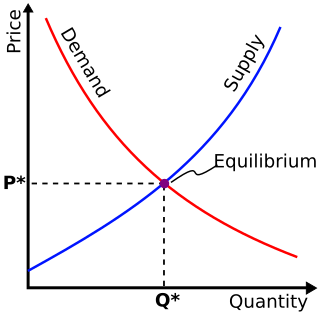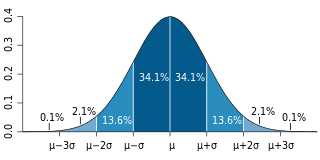
In welfare economics, a Pareto improvement formalizes the idea of an outcome being "better in every possible way". A change is called a Pareto improvement if it leaves at least one person in society better-off without leaving anyone else worse off than they were before. A situation is called Pareto efficient or Pareto optimal if all possible Pareto improvements have already been made; in other words, there are no longer any ways left to make one person better-off, without making some other person worse-off.

Determinism is the philosophical view that all events in the universe, including human decisions and actions, are causally inevitable. Deterministic theories throughout the history of philosophy have developed from diverse and sometimes overlapping motives and considerations. Like eternalism, determinism focuses on particular events rather than the future as a concept. Determinism is often contrasted with free will, although some philosophers claim that the two are compatible. A more extreme antonym of determinism is indeterminism, or the view that events are not deterministically caused but rather occur due to random chance.
Quantum suicide is a thought experiment in quantum mechanics and the philosophy of physics. Purportedly, it can falsify any interpretation of quantum mechanics other than the Everett many-worlds interpretation by means of a variation of the Schrödinger's cat thought experiment, from the cat's point of view. Quantum immortality refers to the subjective experience of surviving quantum suicide. This concept is sometimes conjectured to be applicable to real-world causes of death as well.

Eliezer S. Yudkowsky is an American artificial intelligence researcher and writer on decision theory and ethics, best known for popularizing ideas related to friendly artificial intelligence. He is the founder of and a research fellow at the Machine Intelligence Research Institute (MIRI), a private research nonprofit based in Berkeley, California. His work on the prospect of a runaway intelligence explosion influenced philosopher Nick Bostrom's 2014 book Superintelligence: Paths, Dangers, Strategies.
In philosophy and mathematics, Newcomb's paradox, also known as Newcomb's problem, is a thought experiment involving a game between two players, one of whom is able to predict the future.
In economics and game theory, a participant is considered to have superrationality if they have perfect rationality but assume that all other players are superrational too and that a superrational individual will always come up with the same strategy as any other superrational thinker when facing the same problem. Applying this definition, a superrational player who assumes they are playing against a superrational opponent in a prisoner's dilemma will cooperate while a rationally self-interested player would defect.
In philosophy, an action is an event that an agent performs for a purpose, that is, guided by the person's intention. The first question in the philosophy of action is to determine how actions differ from other forms of behavior, like involuntary reflexes. According to Ludwig Wittgenstein, it involves discovering "What is left over if I subtract the fact that my arm goes up from the fact that I raise my arm". There is broad agreement that the answer to this question has to do with the agent's intentions. So driving a car is an action since the agent intends to do so, but sneezing is a mere behavior since it happens independent of the agent's intention. The dominant theory of the relation between the intention and the behavior is causalism: driving the car is an action because it is caused by the agent's intention to do so. On this view, actions are distinguished from other events by their causal history. Causalist theories include Donald Davidson's account, which defines actions as bodily movements caused by intentions in the right way, and volitionalist theories, according to which volitions form a core aspect of actions. Non-causalist theories, on the other hand, often see intentions not as the action's cause but as a constituent of it.
Friendly artificial intelligence is hypothetical artificial general intelligence (AGI) that would have a positive (benign) effect on humanity or at least align with human interests such as fostering the improvement of the human species. It is a part of the ethics of artificial intelligence and is closely related to machine ethics. While machine ethics is concerned with how an artificially intelligent agent should behave, friendly artificial intelligence research is focused on how to practically bring about this behavior and ensuring it is adequately constrained.
Moral reasoning is the study of how people think about right and wrong and how they acquire and apply moral rules. It is a subdiscipline of moral psychology that overlaps with moral philosophy, and is the foundation of descriptive ethics.

Libertarianism is one of the main philosophical positions related to the problems of free will and determinism which are part of the larger domain of metaphysics. In particular, libertarianism is an incompatibilist position which argues that free will is logically incompatible with a deterministic universe. Libertarianism states that since agents have free will, determinism must be false.

Hard determinism is a view on free will which holds that determinism is true, that it is incompatible with free will, and therefore that free will does not exist. Although hard determinism generally refers to nomological determinism, it can also be a position taken with respect to other forms of determinism that necessitate the future in its entirety.
A temporal paradox, time paradox, or time travel paradox, is a paradox, an apparent contradiction, or logical contradiction associated with the idea of time travel or other foreknowledge of the future. While the notion of time travel to the future complies with the current understanding of physics via relativistic time dilation, temporal paradoxes arise from circumstances involving hypothetical time travel to the past – and are often used to demonstrate its impossibility.
In game theory, a non-cooperative game is a game in which there are no external rules or binding agreements that enforce the cooperation of the players. A non-cooperative game is typically used to model a competitive environment. This is stated in various accounts most prominent being John Nash's 1951 paper in the journal Annals of Mathematics.
In statistics, econometrics, epidemiology and related disciplines, the method of instrumental variables (IV) is used to estimate causal relationships when controlled experiments are not feasible or when a treatment is not successfully delivered to every unit in a randomized experiment. Intuitively, IVs are used when an explanatory variable of interest is correlated with the error term (endogenous), in which case ordinary least squares and ANOVA give biased results. A valid instrument induces changes in the explanatory variable but has no independent effect on the dependent variable and is not correlated with the error term, allowing a researcher to uncover the causal effect of the explanatory variable on the dependent variable.
Probabilistic causation is a concept in a group of philosophical theories that aim to characterize the relationship between cause and effect using the tools of probability theory. The central idea behind these theories is that causes raise the probabilities of their effects, all else being equal.
Causal decision theory (CDT) is a school of thought within decision theory which states that, when a rational agent is confronted with a set of possible actions, one should select the action which causes the best outcome in expectation. CDT contrasts with evidential decision theory (EDT), which recommends the action which would be indicative of the best outcome if one received the "news" that it had been taken. In other words, EDT recommends to "do what you most want to learn that you will do."
Evidential decision theory (EDT) is a school of thought within decision theory which states that, when a rational agent is confronted with a set of possible actions, one should select the action with the highest news value, that is, the action which would be indicative of the best outcome in expectation if one received the "news" that it had been taken. In other words, it recommends to "do what you most want to learn that you will do."
In the field of artificial intelligence (AI) design, AI capability control proposals, also referred to as AI confinement, aim to increase our ability to monitor and control the behavior of AI systems, including proposed artificial general intelligences (AGIs), in order to reduce the danger they might pose if misaligned. However, capability control becomes less effective as agents become more intelligent and their ability to exploit flaws in human control systems increases, potentially resulting in an existential risk from AGI. Therefore, the Oxford philosopher Nick Bostrom and others recommend capability control methods only as a supplement to alignment methods.
In philosophy, Pascal's mugging is a thought experiment demonstrating a problem in expected utility maximization. A rational agent should choose actions whose outcomes, when weighted by their probability, have higher utility. But some very unlikely outcomes may have very great utilities, and these utilities can grow faster than the probability diminishes. Hence the agent should focus more on vastly improbable cases with implausibly high rewards; this leads first to counter-intuitive choices, and then to incoherence as the utility of every choice becomes unbounded.
Roko's basilisk is a thought experiment which states that an otherwise benevolent artificial superintelligence (AI) in the future would be incentivized to create a virtual reality simulation to torture anyone who knew of its potential existence but did not directly contribute to its advancement or development, in order to incentivize said advancement. It originated in a 2010 post at discussion board LessWrong, a rationalist web forum. The thought experiment's name derives from the poster of the article (Roko) and the basilisk, a mythical creature capable of destroying enemies with its stare.





